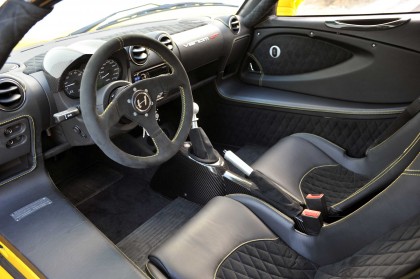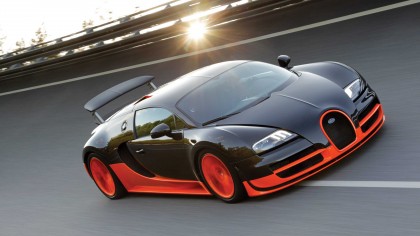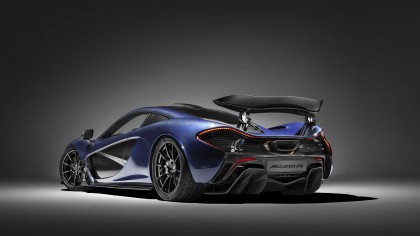The 5 fastest production cars in the world
You'll never go this fast, but it's nice knowing you could.

The fastest cars in the world
Like the intro video to Forza 6 says, we don't know why we race but it's inevitable that we do. One of the reasons we do race is to see how fast we can go. Every year, car manufacturers try to one-up each other with a more powerful, faster accelerating and ridiculously priced cars.
One of the most revered speed metrics is top speed. Foot to the floor, how fast can a car go before hitting maximum velocity. The faster a car goes, the more engineering challenges arise. You have to account for aerodynamic drag, cooling, reliability and car makers even have to work with tire companies to create special tires that can withstand the blistering speeds.
Here is our list of the five fastest cars in the world. Race cars and jet engine powered land speed record cars need not apply.

Koenigsegg One:1 (273 mph / 440 kph)
The Koenigsegg One:1 may have an odd name, but there's meaning behind it. The goal of the car was to get 1 horsepower for every kilogram of weight, and the One:1 delivers just that. The entire car weighs just 2,998 lbs (1360 kg) and produces 1,161 horsepower using regular pump gas from its twin-turbo 5.0L V8. Use ethanol or race gas and that number jumps to a blistering 1,341 horsepower.

The funny thing is that Koenigsegg didn't build the One:1 to be a top speed record breaker. It just happens to go 273 mph. Instead, the One:1 is built to go around corners. It features active aerodynamics that can generate over 1,322 lbs (600 kg) of downforce, carbon fiber everything (even its wheels) and a GPS that can set the suspension to the optimal setting for specific tracks.
Only seven One:1s were made and sold for $2.8 million (£1,936,108) each.

9ff GT9 Vmax (271 mph / 437 kph)
You may not have heard of 9ff, but the German tuning company created one of the fastest production cars in the world. The 9ff GT9 Vmax started out life as a Porsche 911, but you wouldn't know with all the custom work done to it. Its body is styled after the legendary Porsche GT1 LeMans race car to help direct airflow at high speeds.

The 9ff GT9 Vmax features a 4.2L twin-turbo flat six engine that puts out 1,381 horsepower and 855 lb-ft of torque. That's enough to push the 2954 lb (1340 kg) car to 100 kph (62.1 mph) in just 3.1 seconds. The car will reach 300 kph (186.4 mph) in a blistering 13 seconds, all the way up to its 271.53 mph (437 kph) top speed. That's faster than the Bugatti Veyron and on par with the American Hennessey Venom GT.
And the price for all this performance? $1.16 million (€895,000).

Hennessey Venom GT (270 mph / 435 kph)
The Hennessey Venom GT was a controversial car when it debuted back in 2011. The car was involved in a public battle with the Bugatti Veyron to take the Guinness record for the fastest car in the world. The Venom GT managed to reach 270.49 mph (435.31 kph) in 2014, but was disqualified from the Guinness record because it only performed its top speed run in one direction and only sold 16 cars at the time, failing to meet the 50 car quota to be classified as a production car.

That didn't stop the Hennessey Venom GT from breaking other records. The car was able to pull from 0-300 kph in 13.63 seconds, beating the Koenigsegg Agera R as the fastest accelerating car in the world in 2013. Hennessey also claims the car could exceed its recorded 270.49 mph top speed if there was a longer stretch of road, as the car continued accelerating when it ran out of runway.

Powering the Venom GT is a twin-turbo 7.0-liter Chevy V8 pumping out 1,244 horsepower and 1,155 lb-ft of torque. Combined with its light 2,743 lb (1,244 kg) weight and you can see why the Venom GT is one of the fastest cars ever made. And the price? $1.25 million (£862,842).

Bugatti Veyron 16.4 SS (268 mph / 431 kph)
The Bugatti Veyron is a legendary car for many reasons. It delivered astonishing performance when it debuted in 2005 and shattered the world record for fastest car. The ridiculous amount of engineering impressed, with its W16 engine (basically two V8s smashed together) and four turbochargers. The car produced so much heat that it required 10 radiators to cool it down.

The Bugatti Veyron 16.4 Super Sport was a more powerful version of the standard Veyron, producing 1,200 horsepower and 1,100 lb-ft of torque. The Super Sport can reach speeds of up to 268 mph, though the car is limited to 258 mph to prevent its street tires from disintegrating at high speed. This performance earned it the title of fastest street-legal production car in the world by the Guinness Book of World Records.

Only 30 of the Veyron Super Sports were made and were valued at £1.2 million ($1,734,660). All this will be moot when the Veyron's successor, the Chiron, arrives with a 1,500 horsepower W16 motor that will be limited to 261 mph for "road use."

SSC Ultimate Aero XT (273 mph / 439 kph)
Shelby Super Cars, or SSC for short, doesn't have anything to do with race legend Carroll Shelby, but it's made a lightning quick car nonetheless. The SSC Ultimate Aero XT features a twin-turbo V8 putting out 1,300 horsepower and 1,004 lb-ft of torque. That's enough to push the 2,800 lb (1,270 kg) car to a theoretical top speed of 273 mph, though it only reached 253 mph (439 kph) during testing.

Yes, the Ultimate Aero XT is another tuner car like the Hennessey Venom GT, but it's impressive nonetheless. Just don't expect the levels of luxury, technology and sophistication that the Bugatti Veyron or Koenigsegg One:1 provide.

Wrap up
Although all the cars on this list can exceed 250 miles per hour, it's highly unlikely any of its owners will reach their car's top speed. But there's something to be said about knowing that your car can go that fast, and knowing how much engineering has been poured into the car to get it to go that quickly.

Personally, top speed doesn't mean much to me. I'm much more interested in how a car can go around a corner and for that reason, my favorite hypercar is the McLaren P1. It's predecessor, the McLaren F1, held the top speed record for over a decade (240 mph) but the P1 is a decidedly different beast. The P1 was made to attack a race track with its lightweight carbon body, active aerodynamics and state-of-the-art hybrid system.

It's amazing to see the different approaches to reaching top speed by different car manufacturers and tuners alike. Hennessy simply crammed in a powerful engine into a light car while Bugatti used an exotic engine fitted to a luxury car. The cars couldn't be more different but they shared the same goal: going faster than the other guys.
